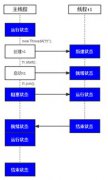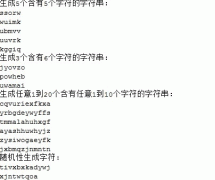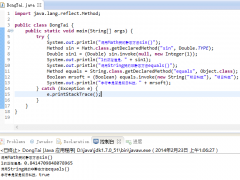学习用于异常处理的terminate()函数
<?XML:namespace prefix = o ns = "urn:schemas-microsoft-com:Office:office" />
异常处理是一个微妙的问题,你应该尽可能优雅地处理所有异常。要达到这个目的,你需要学习terminate()函数。
terminate()函数在程序抛出一个异常并且异常没有被捕捉的时候被调用,像下面这样:
#include
#include
void on_terminate()
{
std::cout << "terminate() 函数被调用了!" << std::endl;
std::cin.get();
}
int main()
{
// 假如用 VC6,去掉“std::”前缀
std::set_terminate( on_terminate);
throw std::exception();
std::cout << "terminate() 函数没有被调用!" << std::endl;
std::cin.get();
return 0;
}
避免这种情形的方案一开始看起来很简单:
int main()
{
try
{
/* code */
}
catch( std::exception & exc)
{
// 记录到日志,或作其他处理
}
catch(...)
{
// 记录下“Unknown exception”
}
return 0;
}
不过,在多线程应用程序中情况变得有点复杂,因为你创建的每个线程都要有上面的(catch)处理过程。
然而terminate()函数在许多其它情况下会被调用,包括:
当你抛出一个异常,并且在它的拷贝构造函数中,另一个异常被抛出。
在堆栈展开的过程中抛出一个异常,此时析构函数抛出一个异常。
当一个静态对象的构造函数或析构函数抛出异常时。
当一个用atexit注册过的函数抛出一个异常时。
当你在代码中写下“throw;”(这意味着重新抛出当前异常),然而并没有当前异常时。
当一个函数抛出一个它的异常说明不答应的异常时
当默认的uneXPected()处理过程被调用时
下面的代码演示了上面各种情况下的结果:
#include
#include
void on_terminate()
{ std::cout << "terminate()函数被调用了!" << std::endl;
std::cin.get(); }
//////////////////////////////// [1]
strUCt custom_exception
{
custom_exception() {}
custom_exception( const custom_exception &)
{ throw std::exception(); }
};
void case_1()
{
try
{ throw custom_exception(); }
catch(...)
{}
}
//////////////////////////////// [2]
struct throw_in_destructor
{
~throw_in_destructor() { throw std::exception(); }
};
void case_2()
{
try
{
throw_in_destructor temp;
throw std::exception();
}
catch(...)
{}
}
//////////////////////////////// [3]
struct static_that_throws
{
static_that_throws() { throw std::exception(); }
};
void case_3()
{
// 注重:用try/catch块包围下面的代码并不起作用
static static_that_throws obj;
}
//////////////////////////////// [4]
void throw_at_exit()
{ throw std::exception(); }
void case_4()
{ atexit( throw_at_exit); }
//////////////////////////////// [5]
void case_5()
{ throw; }
//////////////////////////////// [6]
class custom_6_a {};
class custom_6_b {};
void func_violating_exception_specification_6() throw(std::exception)
{ throw custom_6_a(); }
// 注重:按照我们的例子,在这个函数中我们只应该抛出
// std::exception(在函数func_violating_exception_specification
// 的定义中说明的异常);但我们没有这样做,
// 因此,terminate() 被调用
void on_unexpected()
{ throw custom_6_b(); }
void case_6()
{
std::set_unexpected( on_unexpected);
try
{ func_violating_exception_specification_6(); }
catch(...)
{}
}
//////////////////////////////// [7]
class custom_7 {};
void func_violating_exception_specification_7() throw(std::exception)
{ throw custom_7(); }
void case_7()
{
try
{ func_violating_exception_specification_7(); }
catch(...)
{}
}
int main()
{
std::set_terminate( on_terminate);
// 注重:确保每次仅去掉下面一个调用的注释,
// 以便分析时将每种情况隔离开来
case_1();
// case_2();
// case_3();
// case_4();
// case_5();
// case_6();
// case_7();
return 0;
}
尽管你应该努力避免terminate()函数会被调用的情况,我们还是建议你创建自己的terminate()处理过程。你的处理过程要做的唯一合理的事是记录一条消息到日志中。不管怎样,确保你的日志不会抛出任何异常。
std::ostream& get_log() { /* code */ }
void on_terminate()
{
std::ostream & log = get_log();
// 确保我们不会抛出任何东西!
try
{
log.exceptions( std::ios_base::goodbit);
}
catch (...)
{}
log << "terminate() 被调用了!" << std::endl;
}
int main()
{
std::set_terminate( on_terminate) ;
// . . .
}





